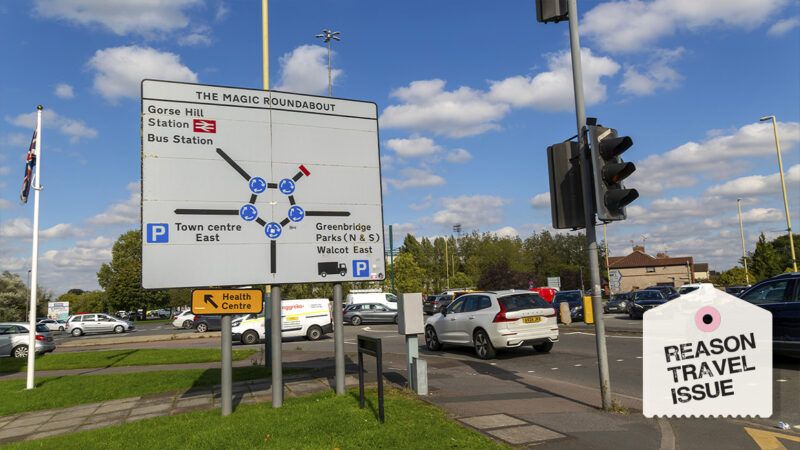The U.K.'s Roundabouts Free Drivers From the Tyranny of Traffic Lights
Roundabouts are more efficient because they let drivers rely on themselves, not an inert piece of infrastructure.

This is part of Reason's 2025 summer travel issue. Click here to read the rest of the issue.
Americans don't agree on much, but nobody enjoys traffic. Our commutes often leave us feeling like we're going in circles. But what if I told you that literally driving in circles is the best, safest, and most efficient form of civil engineering?
Roundabouts are an alternative to traffic lights and stop signs in which the road forms a circle at an intersection. Instead of coming to a complete stop before going straight or turning, cars enter and move clockwise through the circle, yielding to those already in motion but otherwise maintaining some level of speed before exiting in their desired direction. (Though visually similar, roundabouts are different from traffic circles, which have larger medians and lower capacities. While still preferable to traffic lights or stop signs, traffic circles are otherwise mostly decorative. And the less said about traffic lights in roundabouts, the better.)
The law demands a motorist come to a complete stop at a stop sign, no matter if any cars are coming. Traffic lights can offer an advantage: Some use magnets to detect traffic loads, but others run on timers, switching to red even if there's no traffic going the other way. In either case, traffic lights can malfunction, turning into a de facto stop sign the same way a broken escalator becomes an expensive staircase. Besides, frequently stopping, starting, and idling wastes time, wastes gas, and puts unnecessary wear and tear on your brakes.
But at a roundabout, motorists keep driving through the intersection so long as it's safe to do so. This sounds risky, but since everyone slows down a little bit and every car is constantly turning, roundabouts significantly lower the risk of high-speed impacts. "The net result of lower speeds and reduced conflicts at roundabouts is an environment where crashes that cause injury or fatality are substantially reduced," according to the U.S. Federal Highway Administration.
Further, roundabouts are perhaps the least infantilizing form of traffic control. Red lights are just crossing guards for adults, and stop signs require you to wait your turn even if you're the only one waiting. Roundabouts are more efficient because they let drivers rely on themselves, not an inert piece of infrastructure.
Some drivers don't like roundabouts or find them confusing. While there are estimated to be more than 9,000 in the U.S., the modern concept originated in Europe, where drivers are more accustomed to them. "The roundabout is said to have flourished in Britain because it requires the British virtues of compromise and cooperation," London-based journalist Stephen Beard wrote in 2013. "The U.S.'s more aggressive, confrontational culture may explain why the roundabout has not been more widely adopted by Americans."
One particularly complex example is the Magic Roundabout in Swindon, England, built in 1972 and effectively unchanged since. That junction, which connects five roads at a busy intersection, is one giant roundabout that also contains five smaller ones on its outer edges, plus another that runs in the opposite direction around the central median. The complex design allows drivers to take more straightforward routes through the circle, yielding to but otherwise swirling around one another.
Reception is mixed: Last year, the Roundabout Appreciation Society (yes, there is such a thing) named it the U.K. Roundabout of the Year, while in 2007, the BBC named it one of the country's "10 scariest junctions." But despite its complexity and reputation, the Magic Roundabout is very safe, registering only 14 serious accidents in its first 25 years of use.
Of course, there is no such thing as a perfect solution. Some motorists will hate roundabouts or have trouble getting used to them. For that matter, they may not work in every application. But roundabouts ease traffic congestion in perhaps the most libertarian way possible: by empowering motorists to make their own decision at an intersection, rather than having a sign or a signal make it for them.
This article originally appeared in print under the headline "Roundabouts Free Drivers From the Tyranny of Traffic Lights."


Show Comments (66)